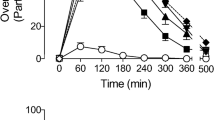Abstract
The effects of diazepam (10–160 mg) and oxazepam (30–480 mg) were studied in volunteers with histories of drug abuse. Oral doses were administered every third day under double-blind and counterbalanced conditions. Dose-effects with area under the time-action curve data (AUC) showed diazepam to be 2.6-5.7-times more potent than oxazepam on various psychomotor, cognitive, staff-rated, and subjective measures. Comparison of relative potencies showed diazepam to be relatively more potent in producing ‘liking’ than in producing psychomotor and cognitive effects. Diazepam produced greater peak effects than oxazepam on a number of staff- and subject-rated measures, including liking. Onset of effect was more rapid and time to maximal effect was shorter (1–2 h versus 4–12 h) with diazepam than oxazepam, while time to offset of effect was similar for the two drugs. Diazepam was categorized as producing barbiturate-like subjective effects (38.3%) more frequently than was oxazepam (13.8%), while oxazepam was identified as placebo more often than diazepam. Repeated administration of 160 mg diazepam and 480 mg oxazepam showed that AUC liking was greater for diazepam than oxazepam and that tolerance to psychomotor and cognitive effects occurred with oxazepam but not diazepam. This study suggests that diazepam may have a higher abuse liability than oxazepam.
Similar content being viewed by others
References
Ayd FJ (1975) Oxazepam: An overview. Dis Nerv Sys 36:14–16
Bailey HR, Davies E, Morrison IJ (1981) Oxazepam in the treatment of anxiety associated with depression: Results of treatment in 1600 cases (studies in depression VI). Curr Med Res Opin 7:156–163
Bliding A (1974) Effects of different rates of absorption of two benzodiazepines on subjective and objective parameters. Eur J Clin Pharmacol 7:201–211
Bliding A (1978) The abuse potential of benzodiazepines with special reference to oxazepam. Acta Psychiatr Scand (Suppl) 274:111–116
Cole JO, Orzack MH, Beake B, Bird M Bar-Tal Y (1982) Assessment of the abuse liability of buspirone in recreational sedative users. J Clin Psychiatry 43:69–75
Fabre LF, Harris RT (1975) Clinical considerations in the abuse of antianziety and antidepressant drugs. In: Kagan F, Harwood T, Rickels K, Rudzik AD, Sorer H (eds) Hypnotics: Methods of development and evaluation. Spectrum, New York 283–291
Finney JD (1964) Statistical method in biological assay. Hafner. New York
Fouks L, Pinalie B, Porcheron JB, Cardon A (1978) The clinical activity of oxazepam. Acta Psychiatr Scand (Suppl) 274:99–103
Greenblatt DJ (1981) Clinical pharmacokinetics of oxazepam and lorazepam. Clin Pharmacokinet 6:89–105
Greenblatt DJ, Shader RI, Abernethy DR, Ochs HR, Divoll M, Sellers EM (1982) Benzodiazepines and the challenge of pharmacokinetic toxonomy. In: Usdin E, Skolnick P, Tallman JF, Greenblatt D, Paul SM (eds) Pharmacology of benzodiazepines. Macmillan, London, 257–269
Griffiths RR, Bigelow G, Liebson I (1979) Human drug self-administration: Double-blind comparison of pentobarbital, diazepam, chlorpromazine and placebo. J Pharmacol Exp Ther 210:301–310
Griffiths, RR, Bigelow GE, Liebson I (1983) Differential effects of diazepam and pentobarbital on mood and behavior Arch Gen Psychiatry 40:865–873
Griffiths RR, Bigelow GE, Liebson I, Kaliszak JE (1980) Drug preference in humans: Double-blind choice comparison of pentobarbital, diazepam and placebo. J Pharmacol Exp Ther 215:649–661
Griffiths RR, McLeod DR, Bigelow GB, Liebson IA, Roache JD, Nowowleski P (1984) Comparison of diazepam and oxazepam: Preference, liking and extent of abose. J Pharmacol Exp Ther 229:501–508
Harvey SC (1980) Hypnotics and sedatives. In: Gilman AG, Goodman LS, Gilman A (eds) The pharmacological basis of therapeutics. Macmillan, New York, pp 339–375
Healey ML, Pickens RW (1983) Diazepam dose preference in humans. Pharmacol Biochem Behav 18:449–456
Hollister LE (1981) Dependence on benzodiazepines. In: Szara SI, Ludford JP (eds) Benzodiazepines: A review of research results, 1980. Natl Inst Drug Abuse Res Monogr 33: 70–83
Jasinski DR, Haertzen, CA, Henningfield JE, Johnson, RE, Makhzoumi HM, Miyasata K (1982) Progress report of the NIDA Addiction Research Center. Natl Inst Drug Abuse Res Monogr 41:45–52
Kaul B, Davidow B (1981) Drug abuse patterns of patients on methadone treatment in New York City. Am J Drug Alcohol Abuse 8:17–25
Martin WR, Sloan JW, Sapira JD, Jasinski DR (1971) Physiologic, subjective and behavioral effects of amphetamine, ephedrine, phenmetrazine and methylphenidate in man. Clin Pharmacol Ther 12:245–258
McLeod DR, Griffiths RR, Bigelow GE, Yingling J (1982) An automated version of the digit-symbol substitution test (DSST). Behav Res Methods Instrum 14:463–466
McNicholas LF, Martin WR, Cherian S (1983) Physical dependence on diazepam and lorazepam in the dog. J Pharmacol Exp Ther 226:783–789
Mohler H, Sieghart W, Polc P, Bonetti EP, Hunkeler W (1982) Differential interaction of agonists and antagonists with benzodiazepine receptors. In: Usdin E, Skolnick P, Tallman JF, Greenblatt D, Paul SM (eds) Pharmacology of benzodiazepines. Macmillan, London, pp 63–70
Pecknold JC, McClure DJ, Fleuri D, Chang H (1982) Benzodiazepine withdrawal effects. Prog Neuropsychopharmacol Biol Psychiatry 6:517–522
Salzman C, Shader RI, Greenblatt DJ Harmatz JS (1983) Long versus short half-life benzodiazepines in the elderly: Kinetics and clinical effects of diazepam and oxazepam. Arch Gen Psychiatry 40:293–297
Schöpf J (1983) Withdrawal phenomena after long-term administration of benzodiazepines: A review of recent investigations. Pharmacopsychiatria 16:1–8
Schuster CR, Fischman MW, Johanson CE (1981) Internal stimulus control and subjective effects of drugs. In: Thompson, T, Johanson CE (eds) Behavioral pharmacology of human drug dependence. Natl Inst Drug Abuse Monogr 37:116–129
Stitzer ML, Griffiths RR, McLellan AT, Grabowski J, Hawthone, JW (1981) Diazepam use among methadone maintenance patients: Patterns and dosages. Drug Alcohol Depend 8:189–199
Tyrer P, Rutherford D, Huggett T (1981) Benzodiazepine withdrawal symptoms and propranolol. Lancet 1:520–522
Usdin E, Skolnick P, Tallman JF, Greenblatt D, Paul SM (1982) Pharmacology of benzodiazepines. Macmillan, London
Walters L, Nel P (1981) Die athanklikheidspotensiaal van die bensodiasepiene. S Afr Med J 59:115–116
Author information
Authors and Affiliations
Rights and permissions
About this article
Cite this article
Griffiths, R.R., McLeod, D.R., Bigelow, G.E. et al. Relative abuse liability of diazepam and oxazepam: Behavioral and subjective dose effects. Psychopharmacology 84, 147–154 (1984). https://doi.org/10.1007/BF00427437
Received:
Accepted:
Issue Date:
DOI: https://doi.org/10.1007/BF00427437




